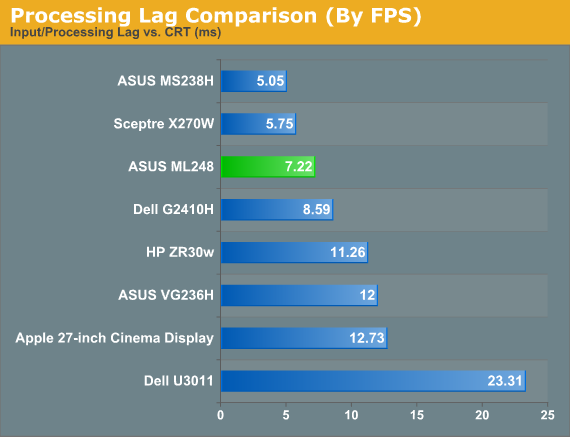ASUS ML248H: Thin for the Win?
by Chris Heinonen on October 27, 2011 12:00 AM ESTLag Measurements and Gaming
The lag measurements for the ASUS ML248H are pretty good overall, as that is one area where a TN panel can outperform other display types. The average result of 7ms is less than half a frame of lag when you run at the normal 60 Hz refresh rate for an LCD. Looking carefully at the data just over half of the results had no lag at all when compared to the CRT, and the other half suffered from what would be considered one frame of lag. Enabling or disabling Trace Free mode doesn’t seem to affect the results, but it does affect how the monitor looks.

During normal work, like word processing or web browsing, I found that Trace Free has a strange ghosting effect when scrolling text up or down in a window, and it’s something that I found distracting. Disabling this setting gave me more normal results and so I typically left it off. I tried both modes for gaming but I was not able to notice a particular difference. Perhaps I just don’t play games enough—or I’m not good enough—to notice the difference in response times, but in my experience there isn’t a difference. Compared to the E-IPS and *VA panels I also tested recently, I had no noticeable differences for gaming performance.










57 Comments
View All Comments
Arbie - Friday, October 28, 2011 - link
How can a major company produce any monitor today without a height adjustment? And especially an ultra-thin product, where the mechanical parts required to do so would be minimal. This immediately rules it out of the workplace (where there are legal ergonomic concerns), and off most other people's desktops. Get a clue, Asus. Garden-variety Samsungs have lift, tilt, and even rotation.
JonnyDough - Friday, October 28, 2011 - link
I won't buy anything under 120Hz these days. I do however like the 2ms response time. That meets my standard. Anything over 5ms is a no go for sure. I aim for 2 usually.marraco - Saturday, October 29, 2011 - link
The first and most important aspect I look for on any monitor review is blurring of moving images.This article is completely worthless to me.
shashank7040 - Tuesday, November 1, 2011 - link
Asus Eee Pad with slide out QWERTY.........http://goo.gl/B4rJUm0nsier - Saturday, November 5, 2011 - link
I bought the 21.5in version of this monitor (ML228H) for a mere $133 AR. It is surprisingly light and thin. I use it as a portable display for my PS3 (HDMI) which is where the headphone jack comes in handy. It also works well as a second monitor for my laptop, which also uses HDMI. A beautiful display for my gaming/office/web browsing needs, and much better quality than another brand 22" I purchased 2yrs ago. Note: I am not a graphic artist so i cannot compare my experience to an IPS.As for the omission of DVI, my ASUS monitor came with a DVI to HDMI cable for connecting to DVI out, as well as a VGA cable. Both cables approximately 6ft in length. Perhaps the AT reviewer also lost this cable when he lost his screw. Even so you can buy DVI to HDMI adaptors for pocket change.
mbryans - Tuesday, November 22, 2011 - link
Bisakah Anandtech making review about Samsung SyncMaster S23A750D? This monitor seems to be reincarnation of the SyncMaster PX2370.TN Panel (probably hybrid), LED backlit, 23-inch, 1920 x 1080, 2 ms, 120 Hz (3D only for AMD 3D HD), 100% sRGB, and DisplayPort 1.2 (probably first DP 1.2 monitor).
I am interested in the color accuracy of this monitor will be displayed at 120 Hz.
mbryans - Tuesday, November 22, 2011 - link
I mean: Can Anandtech review about Samsung SyncMaster making S23A750D? This monitor seems a to be Reincarnation of the SyncMaster PX2370.